Aprilia RSV4
Aprilia’s superbike has been the closest a mass-production streetbike has replicated a MotoGP
race machine since its introduction in 2009. Its V-4 engine replicates a
GP bike’s, and its concentration on mass-centralization is something
all riders can dynamically feel. It received near-universal acclaim from
motojournalists, then went on to capture three World Superbike championships, including the 2014 WSBK title in the hands of Sylvain Guintoli.
But the RSV4 has become overshadowed by new, fresher and faster machines, primarily from European rivals like Ducati and BMW and, in the past couple of months, by Yamaha’s trick new R1.
Tired of getting asphalt kicked in its
streetbike face, the RSV4 comes ready for battle with a significant
revamp for the 2015/2016 model year, not least of which is a 16-hp bump
in peak output to a claimed 201 horsepower at its crankshaft.
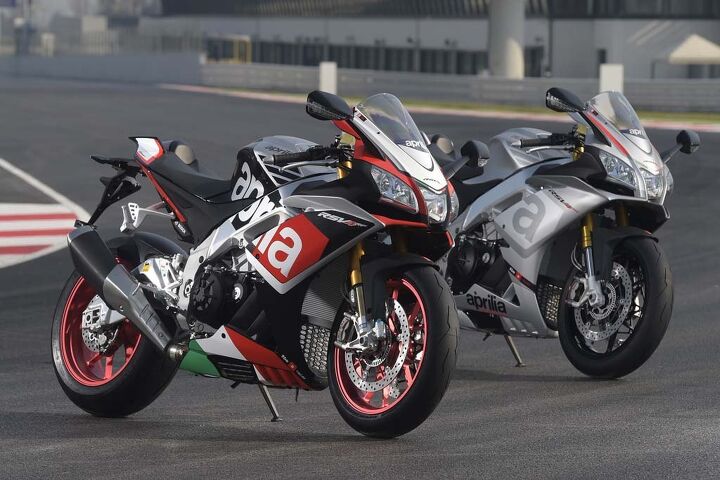
The
RSV4s arriving in North America in the next two months look outwardly
similar to the previous generation. Tweaks to the nose section are the
visually defined updates, using rounder, more aerodynamic panels and a
windscreen taller by 30mm. Headlights are also new, with an LED position
light at center. New mirrors also incorporate LED turnsignals. The RSV4
in front is the RF version in its special “Superpole” graphics. The
bike in the rear is the standard RR, and has everything the RF does
except forged aluminum wheels and Öhlins suspension and steering damper,
with its own Bucine Gray colorway. The RR retails for $16,449, while
the RF lists for $21,999.
This new model looks quite similar to the previous generation, and
there are indeed many carry-over items. Still, there are scores of new
pieces, most of them not outwardly visible because they’re inside the
engine. Nearly everything but its 65-degree V-4 architecture is new, all
designed to improve efficiency via optimized fluid dynamics, combustion
and weight reduction:
- Airbox: WSB rules now mandate stock airbox specs, so Aprilia’s engineers spent considerable efforts examining computational fluid dynamics (CFD) for a straight and smooth intake pathway inside a marginally larger volume.
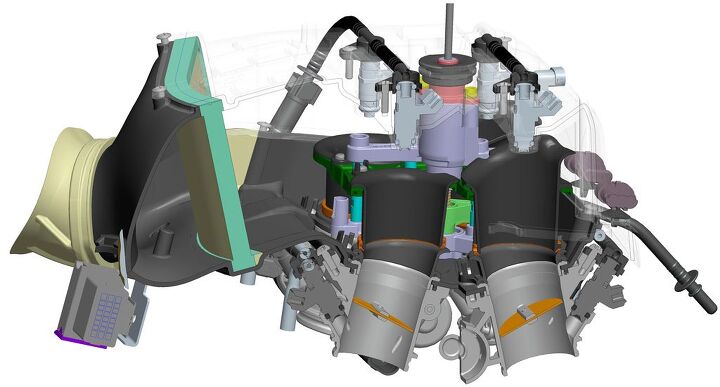
- Variable-length intake snorkels (now on the base RR not just the Factory model) enjoy a greater breadth of lengths to deliver a broader swath of power. Longer funnels offer improved low-end and midrange performance, while the shift to its shorter funnels is intended to deliver a stronger pull up top.
- Camshafts with revised profiles are now forged (instead of cast), saving a total of 600 grams over its four bumpsticks.
- Intake valve diameters go up 1mm to 33mm.
- Exhaust valves swap steel for titanium like the intake poppets.
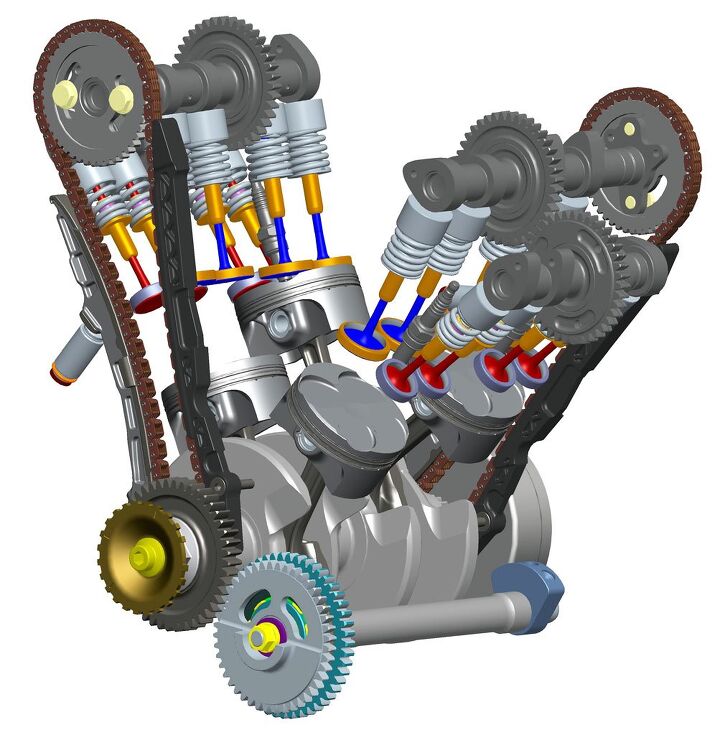
- Valve springs are new, with the intake springs now using oval-section wires. Valve tappets and caps are slightly lighter.
- Cylinder heads are now CNC-machined for optimum flow and consistency via massaged geometries. Aprilia Product Development engineer Piero Soatti says this was a very important modification to the new engine.
- The compression ratio now sits at a stratospheric 13.6:1.
- Forged aluminum pistons are each 30 grams lighter.
- Conrods scale in at 100 grams less per cylinder for a total of 400 grams (nearly 1 lb) less weight.
- The crankshaft gets one pound of weight added to it, which makes it stronger and, perhaps, slightly more tractable to ride at low revs.
- Crankcases retooled to incorporate new oil circuits and a larger oil tank mounted lower. The upper half of the crankcase is lighter by 2.9 lbs. Revised internal passages reduce pumping losses at high engine speeds.
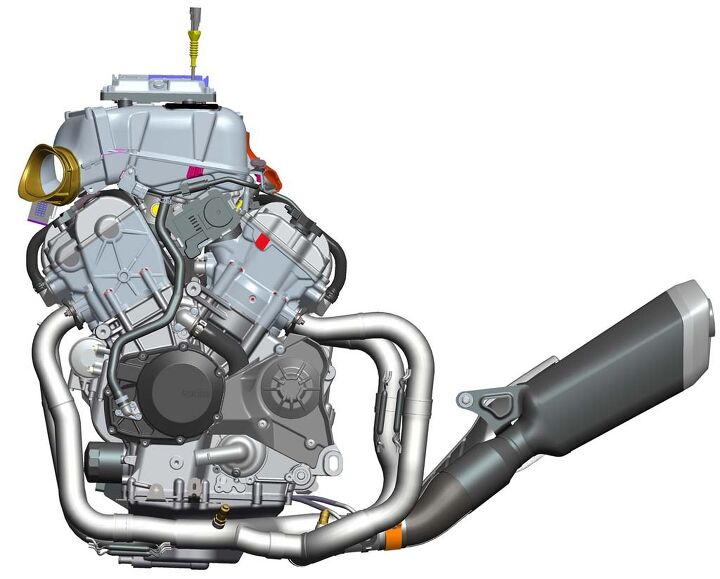
- The combination of these lighter internals allow the rev ceiling to be lifted from 14,100 to 14,200 rpm
- Primary drive and transmission gears are lightened, the latter with tweaked ratios better suited for the engine’s increased power.
- Exhaust system is new with larger diameters and revamped valve management.
- The ECU receives added processing power.
- Horsepower jumps from 185 at 12,500 rpm to 201 at 13,000 rpm.
- Torque dips slightly, going from 86.3 lb-ft at 10,000 rpm to 84.8 lb-ft 500 revs higher.
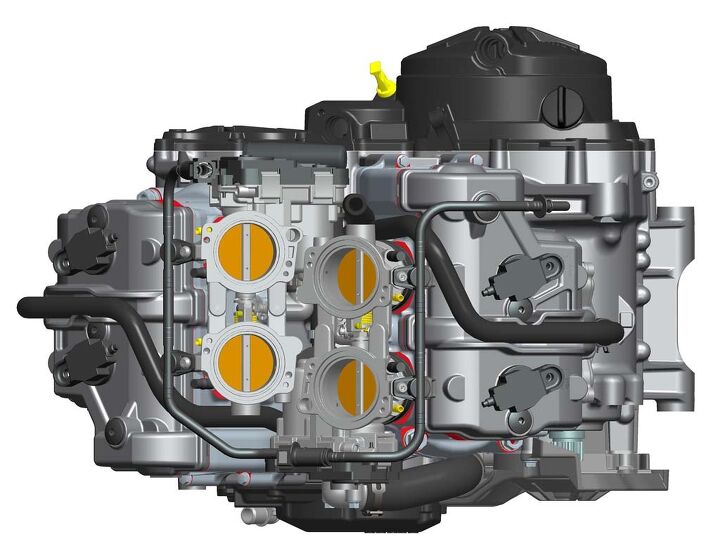
Aprilia’s
four-cylinder engine is a marvel of packaging. Note how the two banks
of throttle bodies are offset, allowing extra compactness from its
65-degree vee angle. It also produces what might be the sweetest exhaust
note in the history of streetbikes.
Whew, that’s a whack of engine mods. Changes to the rest of the bike are much less comprehensive.
Chassis-wise, the RSV4’s twin-beam aluminum frame remains the same,
but the engine is now set to the bottom position in the frame’s
adjustable mounts (5mm lower) to lower the bike’s center of gravity. The
previous R models did not have the Factory model’s adjustable engine
mounts but now do. Its aluminum swingarm has been stretched 14mm in
length and its chain adjustment slots have been lengthened. Wheelbase
elongates from 55.9 inches to 56.5 inches, making it less eager to pitch
rearward – wheelies slow laptimes. The triple-clamp offset gains 2mm,
while the front axle shifts 2mm rearward, combining to yield a trail
figure of 105mm and steepening its rake angle 1.5 degrees to 25.0
degrees.
According to Aprilia, the latest RR scales in about 2 lbs lighter
than the previous R at 195 kg wet (all fluids except fuel), which is 430
lbs in U.S. money. Add in about 29 lbs for 4.9 gallons of fuel for a
curb weight of 459 lbs. It should be noted that the adjustable engine
mounts and variable-length intakes added to the RR pack on some extra
mass to that particular model. Weight added to both the RR and RF
include a stronger starter motor and the longer swingarm. The
limited-production RF also loses 2 lbs compared to its predecessor, now
purportedly at 419 lbs, which would put it near 448 lbs full of fuel.
The last RSV4 Factory we tested in 2013 scaled in at a class-trailing
464 lbs with its 4.9-gallon fuel tank full, so those figures might be
optimistic.
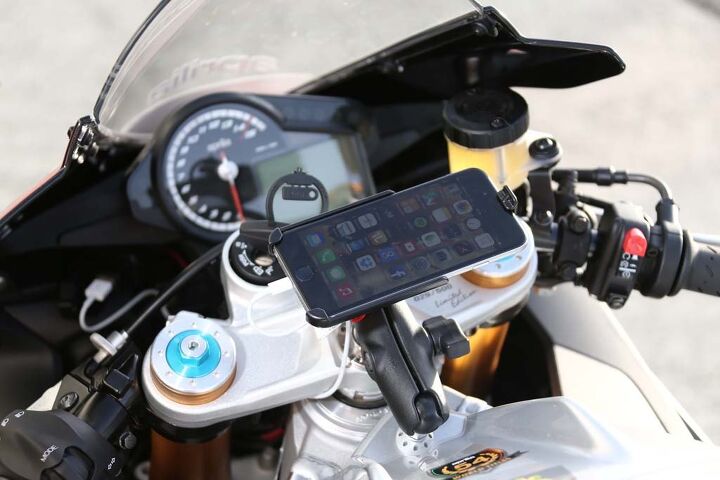
One
aspect of this launch was unprecedented: the test bikes were fitted
with iPhones! Aprilia’s V4 Multimedia Platform app connects the RSV4 to
smartphones and, then, the motorcycle to the internet!
In its simplest form, Aprilia’s V4-MP is a datalogger, recording lap
times, throttle positions, gears selected, speeds, etc, whether on a
mount or in a pocket. It can also display uncommon parameters such as
the amount of horsepower and torque being transmitted, rear-wheel
slippage, lean angle and longitudinal and lateral g-forces. And there
are also some incredible features that are nearly at the level of MotoGP
tech.
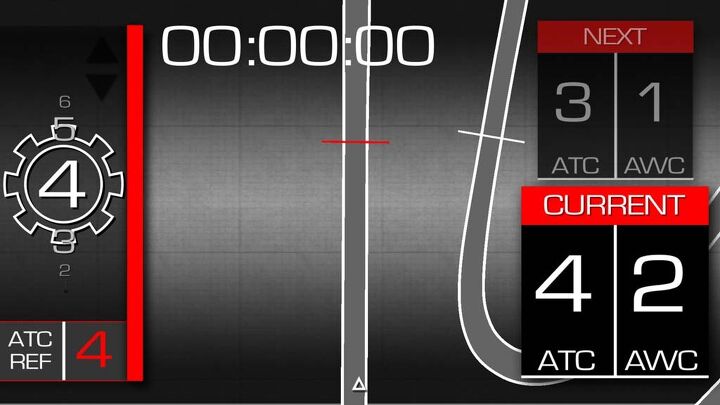
Here
is one of many screens that can be displayed on your smartphone from
the V4-MP app. On the left is gear position, and a lap-time readout can
be seen up top. Big deal. But the mind-blowing aspects can be seen on
the right. Aprilia Traction Control is currently set to the fourth
position, while Aprilia Wheelie Control is set to its second of three
choices. It’s the “Next” category above that astonishes. Your phone uses
its GPS function to know where you are on track, and you can set the
app to change the RSV4’s TC and WC settings at various points around a
racetrack! In the Next section here, perhaps the track has more grip and
higher speeds, requiring less TC and WC.
The app can also aid your pursuit of quicker laptimes via the
adaptive race assistant function. It compares a rider’s best lap with
the pilot’s current lap and can provide riding tips in real time. So,
it’ll tell you, for example, if you’ve braked later in previous laps or
if you’ve opened the throttle earlier or bigger during other laps. I
didn’t actually test this feature, as delayed flights kept me from the
bike’s tech presentation and I didn’t know about it. I wonder if it
might be a distraction and better used during analysis after your stint.
Aprilia previously offered the regular R and the premium Factory
versions of the RSV4. For this latest generation, the Factory is dropped
in favor of the RF we were in Italy to sample. The RF, like the
Factory, upgrades to Öhlins suspension, forged wheels and its special
paint.
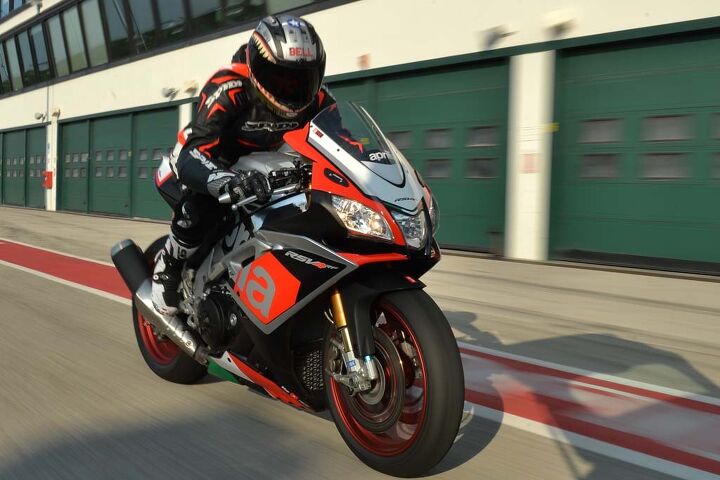
Unlike
the Factory, the RFs are limited in production to just 500 globally,
with a X/500 number applied to the triple clamp. My fan club will want
to keep an eye out for #20, upon which my butt sat for four invigorating
sessions at Misano.
The former RSV4 R gains an extra R, now the RR, and it makes do with
Sachs/Marzocchi suspension and cast wheels. We’re told they won’t arrive
in America until September, which, since these RSV4s are classified by
Aprilia USA as 2016 models (but 2015s in Europe), seems almost well
timed. The RF versions will arrive in June.
Nomenclature and apps were at the back of my mind as I sauntered up
to the new RSV4. I was anxious to ride a new version of a bike I’ve
enjoyed since its inception, but other than the iPhone clamped to this
new version, it didn’t look or feel different from the cockpit –
handlebars are said to be higher, but I didn’t realize this until I got
home and read the press kit. The seat’s still a fairly lofty 33.6 inches
high, and the unchanged instrumentation looks dated in a world of TFT
panels. Still, this is surely one of the most visually stimulating
sportbikes ever made. It looks chiseled but sleek, compact yet muscular.
And the sounds!
Music and motorcycles have occupied the bulk of my life, and the
RSV4’s tuneful exhaust note meshes music and motors in a truly
mellifluous cacophony. It’s heaven and hell, sweet and seething,
operatic and punk. If I were to choose an engine to sit in my living
room to be fired up for a daily session of throttle blipping solely for
my aural pleasure, you’d have a tough time convincing me it shouldn’t be
this one. The V-4 would be a great engine even if it made only 100
horsepower.
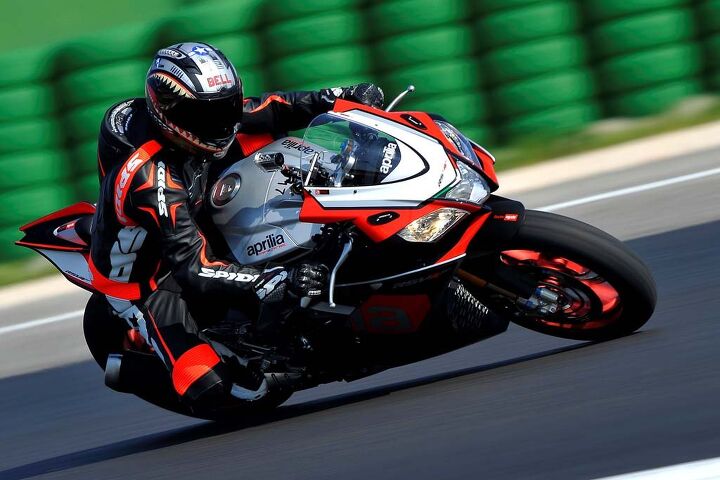
That said, I was grateful that the V-4 jewel has 201 ponies claimed at its crank, which produces acceleration that made GP-hosting Misano seem almost small. Gears are gone through quickly, with Aprilia’s quickshifter snapping off no-lift gear changes in an instant. Soon, we’re well into triple-digit speeds and happy to have a little more fairing and windscreen to tuck behind.
The extra power from the engine makes the bike want to wheelie through the first three gears despite Aprilia’s lowering of the RSV4’s center of gravity. I set wheelie control to its least intrusive setting, #1, and AWC never let the front tire further from the ground than six or so inches – just keep the grip pinned and enjoy the feeling of eyeballs pressing into your frontal lobe. If I were really picky, I’d claim the new R1’s wheelie-control system more smoothly keeps the front end close to the road.
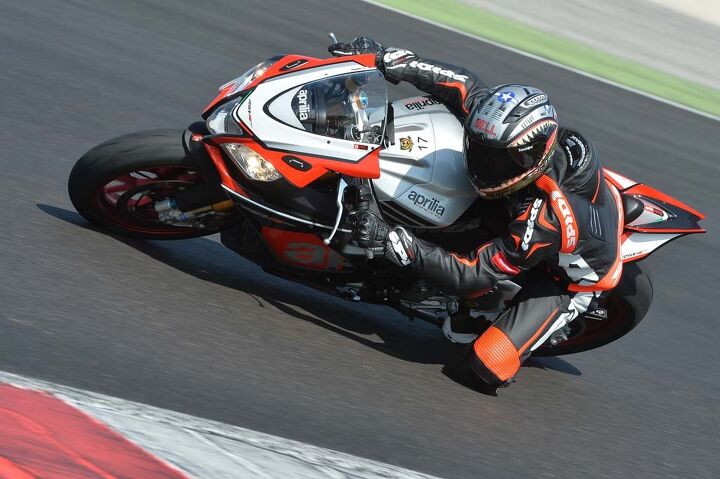
The
RSV4 RF makes the job of a critic quite difficult. Our test bikes wore
Pirelli Supercorsa SC2s instead of the Supercorsa SPs equipped as stock
rubber.
Aprilia’s traction-control system is of the few that can be adjusted while riding (via a thumb/forefinger toggle) and without requiring the throttle be closed. It seems to have had a software upgrade, or maybe it was just the new, grippy surface at Misano, as it was rare to see the TC indicator light flash when ATC was set to its lowest position.
Brembo takes responsibility for scrubbing off speed, here playing in concert with Bosch and its 9MP ABS system. The Brembo M430 front calipers are powerful without excessive initial bite. Leaving my brake markers later and later gave the binders a good workout, and they responded predictably and without fade – though not quite up to the stellar Brembo M50 clampers as fitted to Ducati’s Panigale and KTM’s Super Duke.
Bosch’s 9MP ABS unit weighs just 5 lbs, has three levels of intervention and can be disabled if desired. The #1 setting, designed for track use, is very difficult to intrude on even fast riders. The level 2 and 3 settings feature Rear Lift-up Mitigation, which prevents stoppies.
I had noticed the RSV4’s front end weaving during acceleration, which I initially believed was simply a product of 200 horses trying to get transferred to the ground. Then I realized the RSV4 has the benefit of an Öhlins steering damper. It was set to five positions out from max, so I added two clicks and immediately noticed a large uptick in stability during acceleration at the expense of some agility. It allowed the throttle to be held open more often and for longer.
As previous, the RSV4 inspires confidence, with its mass-centralized architecture benefiting steadiness, especially during corner entries. There didn’t seem to be a limit to how hard the front end could be pushed into a corner. Heading into Curvone, a kink following a straight section, I was able to drag my knee at 150-plus mph.
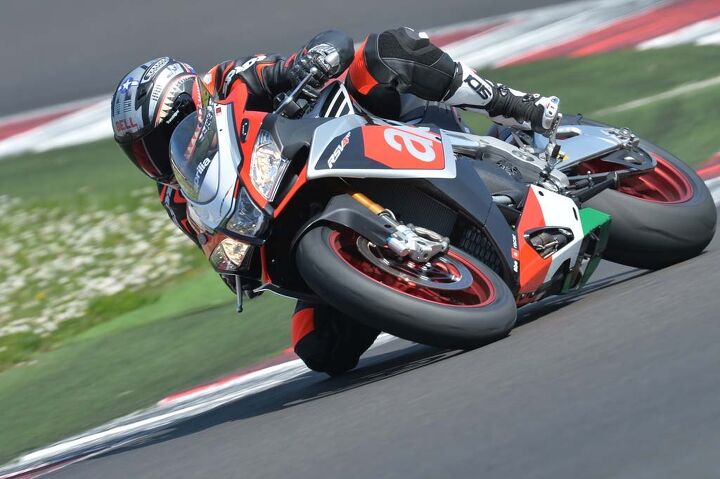
The
RSV4 makes a rider want to go quicker and faster. Wind protection is
improved, which pays benefits at the track and surely will on the
street, too.
Conclusion
The only thing stopping the RSV4 from taking top honors in the streetbike literbike wars is the fervent competition for bragging rights in this dazzling category. BMW’s updated S1000RR will surely run with the Aprilia, as will the oversized Ducati 1299. And then there’s Yamaha’s new R1, which may have taken the lead in terms of technical superiority in electronic rider aids.Funny thing is, the R1 retails for $16,490, an $841 premium over the exotic RSV4 RR’s $15,649. The RSV4 RF has a price tag just $9 over that of the trick R1M. What’s left to find out is how sheer performance mixes with electronics and the strong personalities of each contender. Whatever the result of our upcoming shootouts, no one choosing a new RSV4 will ever consider their ride as dull or poorly engineered. It’s a thrill ride that’ll never get old.
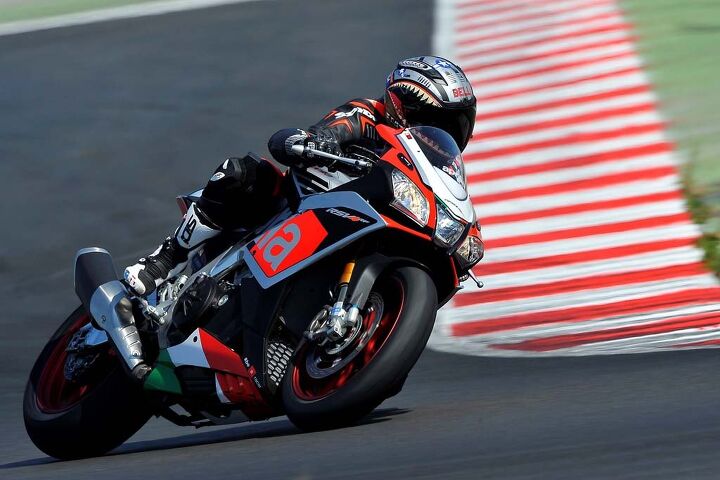
+ Highs
|
– Sighs
|
| 2016 Aprilia RSV4 RR Specifications [RSV4 RF data in brackets] | |
|---|---|
| Engine | 65° V-4, 4-stroke, liquid-cooled with dual overhead cams and four valves per cylinder |
| Bore and stroke | 78 x 52.3mm |
| Engine capacity | 999.6cc |
| Compression ratio | 13.6:1 |
| Maximum power at crankshaft | 201 HP (148 kW) at 13,000 rpm |
| Maximum torque at crankshaft | 115 Nm at 10,500 rpm |
| Fuel system | Four Marelli 48mm throttle bodies with 8 injectors; variable-height intake ducts |
| Ignition | Magneti Marelli digital electronic ignition system integrated in engine control system, with one spark plug per cylinder and stick-type coils |
| Lubrication | Wet sump lubrication system with oil radiator and two oil pumps (lubrication and cooling) |
| Gearbox | 6-speed cassette-type gearbox |
| Clutch | Multi-disc oil-bath, with mechanical slipper system |
| Traction management | aPRC System (Aprilia Performance Ride Control), which includes Traction Control (aTC), Wheelie Control (aWC), Launch Control (aLC) |
| Frame | Aluminum dual-beam chassis with pressed and cast sheet elements. |
| Front suspension | Sachs Fork with 43mm stanchions; [Öhlins Racing Fork with TIN surface treatment]. Adjustable spring preload and hydraulic compression and rebound damping; 120mm of travel. |
| Rear suspension | Double-braced aluminum swingarm; mixed low thickness and sheet casting technology. Sachs monoshock adjustable in rebound and compression damping and spring preload; 130mm of travel [Öhlins Racing monoshock with piggy-back, fully adjustable |
| Front brakes | Dual 320mm floating stainless steel disc with lightweight stainless steel rotor and aluminum flange with 6 pins. Brembo M430 monoblock radial callipers with 4 30mm opposing pistons. Sintered pads. Radial pump and metal braided brake hose |
| Rear brake | 220mm diameter disc; Brembo caliper with two 32mm pistons. Sintered pads. Pump with integrated tank and metal braided hose. |
| ABS | Bosch 9MP ABS, adjustable to 3 maps equipped with RLM (Rear wheel Lift-up Mitigation) – can be disabled. |
| Wheels | Aluminum alloy with 3 split spokes, [forged aluminum alloy with 5 split spokes, completely machined]. 3.5”X17” front; 6”X17” rear |
| Tires | Pirelli Supercorsa SP, 120/70 ZR 17 front; 200/55 ZR 17 rear |
| Dry weight without battery and fluids | 180 kg* (397 lbs) |
| Wet weight without fuel | 190 kg (419 lbs) |
| Fuel tank | 4.88 gallons including 1 gallon reserve |
| MSRP | $15,649 ($21,999) |
New Aprilia RSV4 First Ride Review 2016
![New Aprilia RSV4 First Ride Review 2016]() Reviewed by masbantuu
on
12:03 AM
Rating:
Reviewed by masbantuu
on
12:03 AM
Rating:



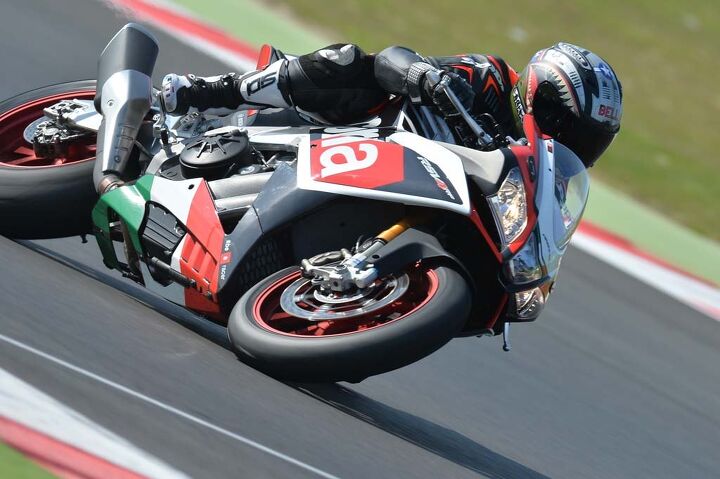

No comments:
Post a Comment